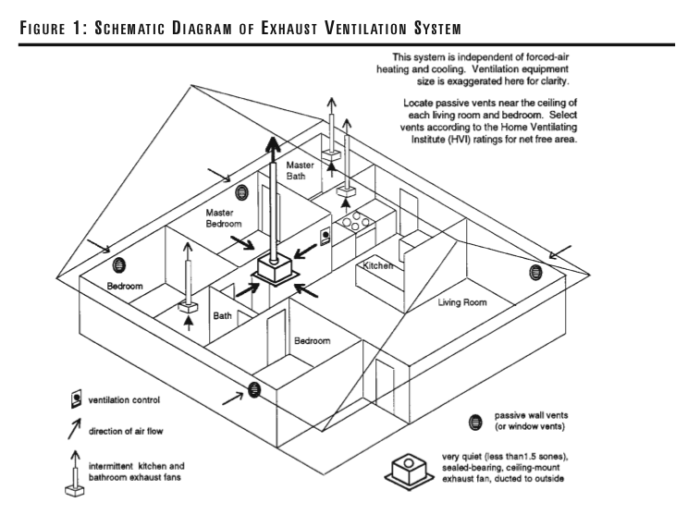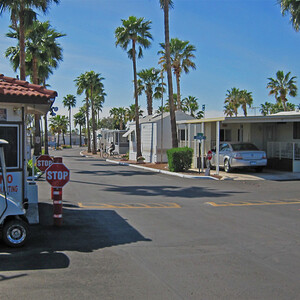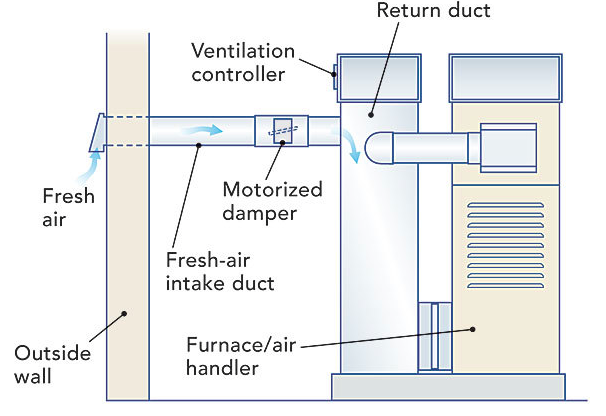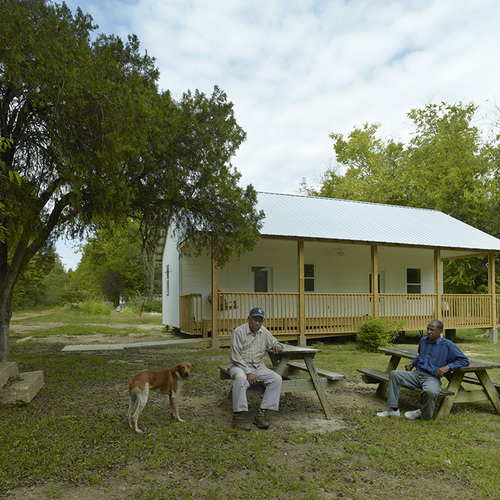Image Credit: EPA Energy Star
Everyone needs fresh air; it’s just hard to figure out how much we need when we are indoors. Enterprise Community Partners’ (ECP) Green Single Family Rehab Specs (2008) requires a ventilation system to meet ASHRAE 62.2 for “substantial rehabilitation” (essentially gut rehabs) and then cites a source for the ASHRAE standard and a source reviewing types of residential ventilation systems. Quite a lot to digest here so let’s break it down.
What is ASHRAE 62.2?
ASHRAE is the professional organization for HVAC engineers and they spent a heck of a lot of time and effort (and pain) hammering out what they thought were reasonable and effective ventilation requirements for homes. This is tricky for homes because volume of space, number of occupants, and contaminant loads (moisture, odors, air-borne chemicals, etc) vary quite widely from home to home. It’s also tricky because you can ventilate too little and compromise occupant health or ventilate too much and waste energy and money. The rate of ventilation in ASHRAE 62.2 turns out to be about that of a typical bath exhaust fan for a 2000 square foot home. For more background, see the GBA Green Basics section on Ventilation Choices.
How tight does a home have to be to require mechanical ventilation?
All homes leak air: we open and close doors and windows, we turn on spot exhaust fans in the kitchen and baths, we run devices that pull air through the home (clothes dryers, fireplaces, water heaters and furnaces with open flues). How do we know when we have made a home, particularly an older existing home, air tight enough to require whole-house mechanical ventilation? ASHRAE 62.2 states that any home tighter than 0.35 air changes per hour needs a dedicated, systematic ventilation approach (that means approximately all the air in a home being replaced every 3 hours). That is pretty much why the ECP green rehab specs for full gut jobs require ASHRAE 62.2 compliance; by the time you get done the specs for air sealing and insulating, you will have tightened up the home enough so that you need to introduce a mechanical ventilation system.
What systems make the most sense for affordable housing renovation?
GBA editor Martin Holladay has a great blog on types of ventilation systems. The two most affordable yet effective ventilation systems are exhaust-only and central fan-integrated supply.
Exhaust-only ventilation
This system can be as simple as an Energy Star bath exhaust fan installed to run at the appropriate rate either all the time or at a higher rate intermittently on a schedule to satisfy ASHRAE 62.2 (see Figure 1, although this is a more complex exhaust-only system). The advantages to exhaust-only systems are: low first and installed cost, and appropriate in all climates and types of homes. The cost chart from the recommended BSC ventilation article lists the installed cost for a single-point exhaust system as $300 (2005). The retrofit installation portion of the total cost is, of course, affected by how easy it is to install the fan and how long or complicated the duct runs are.
The major disadvantage to this system is distribution; with only one point of draw it is easy to over-ventilate one space and under-ventilate others. As a result, exhaust-only systems work best in smaller homes with open floor plans. A key to this system’s effectiveness is quality installation; don’t pay for a good fan and then get a lousy installation with loose and lengthy ducts with lots of twists and turns. The straighter and shorter the duct runs, the better.
Some builders add make-up air inlets to their exhaust-only ventilation systems. This means that the air pulled into the home to supply the exhaust comes from these inlets rather than from sundry cracks and random air leaks. Many building scientists argue that how much and which direction these inlets permit air flow is dependent on forces (such as wind) that can make them just as unpredictable in their operation as random cracks. If you do use air inlets, make sure you locate them away from sources of lousy air.
Central-fan integrated supply (CFIS) ventilation
This system runs an intake duct to the return plenum or trunk of your forced-air system and then uses the blower fan to intermittently pull in outside air per ASHRAE 62.2 requirements (see Figure 2). The advantages to this system are: low first and installed cost, appropriate for all climates, and excellent distribution (since the forced air duct system mixes the fresh air with all the other air it is moving about the house). The same BSC ventilation cost chart lists the CFIS installed cost at about $300 as well. Again, the cost for retrofit installation of this system depends on just how easy it is to add a duct running from a good exterior wall location to the return plenum or return trunk.
The disadvantages to this system are: it is really only feasible in homes with central forced-air systems and its operating costs over a year can be much higher than other systems. The higher operating cost is because a large and often energy inefficient central air handler must run to pull in and distribute the outside air. Of course, the more your air handler is running anyway to distribute cooled or heated air, the less the air handler is running JUST to do ventilation. So, the marginal operating costs of the CFIS system can vary by climate.
Weekly Newsletter
Get building science and energy efficiency advice, plus special offers, in your inbox.
















19 Comments
ACH threshold for ventilation
This article states:
"ASHRAE 62.2 states that any home tighter than 0.35 air changes per hour needs a dedicated, systematic ventilation approach (that means approximately all the air in a home being replaced every 3 hours)."
How does this ACH number translate to an ACH number taken from a blower door reading at 50 Pascal pressure?
I once had a conversation about sizing a heating system with an HVAC engineer. After performing a blower door test on a turn century home that had went through several remodels I determined that the home was in excess of 10 ACH at 50 Pascal. For the purposes of factoring infiltration for sizing the heating system the engineer advised to use .3 ACH. I don't understand the discrepancy.
Given that blower door tests at 50 Pascal of 1.5 are commendable for tight building construction (.6 if your following Passivhaus) I'm assuming that the ACH the engineers are speaking of are either at a different pressure differential or already include the contribution of a outside air exchange system.
Please clarify.
Response to J. Chesnut
J. Chesnut,
The sentence you quote is referring to "natural infiltration," sometimes referred to as ACH(nat). Natural infiltration varies greatly by season and by climate. It is not the same as normalized leakage, although its value may be similar. Rules of thumb for calculating ACH(nat) vary by climate. In Minnesota, ACHnat equals approximately ACH50 divided by 17, while in Florida, ACHnat equals approximately ACH50 divided by 30.
Remember that ACH(nat) is an estimate. Actual air changes per hour will vary widely, depending on wind speed and outdoor temperature.
Moving from ACH50 to "nACH"
There is a very useful table for this conversion in John Krigger's book, Residential Energy. It's Appendix A-11 and uses numbers developed by George Tsongas based on methodology developed by Lawrence Berkeley National Laboratory. The table factors in building height, site exposure, and geographic location to arrive at the best estimate for the divisor.
varying levels of quality for CFIS systems?
Thank you Martin and Peter for clarifying the distinction between ACH50 and nACH.
I worked on a new construction project built to Passivhaus standards where we employed a balanced ventilation system using small diameter flexible ductwork all of which was home run to the ventilation unit (as opposed to a trunk and branch distribution). This is an ideal system for uniform distribution, controlability and low operational energy. The installation was very easy for new construction and potentially so for retrofits if a chase space is available to an attic area. The separate unit and ductwork have a cost associated with it (approx. $7k for a moderately sized home) but we bring this option to our retrofit clients when the circumstances would allow for easy installation.
For some current projects we need to research CFIS options more because budget won't allow for the balanced system. We are uncomfortable with a CFIS system because we see some questionable existing ductwork installation and can't determine with any certainty what the actual fresh air distribution would be in reality. We also wonder if the existing ductwork is not able to be cleaned thoroughly how much the fresh air distribution is compromised. I suppose determining the distribution to each room would entail measuring the force of the supply air at each supply register in the house.
This article states: "This system runs an intake duct to the return plenum or trunk of your forced-air system and then uses the blower fan to intermittently pull in outside air per ASHRAE 62.2 requirements (see Figure 2)." How does the ventilation system control outside air intake per ASHRAE 62.2? Sensors? A damper set at a schedule? I would expect some systems have better control systems then others. What should we look for in a system's specs?
Response to J. Chesnut
J. Chesnut,
A central-fan-integrated supply ventilation system must be commissioned. In order to determine the fresh air flow when the air handler fan is operating, the person who is commissioning the system measures the air flow. A mechanical damper can be adjusted as necessary to achieve the desired air flow.
Once the air flow is adjusted, the AirCycler controller can be programmed to operate the fan (or the motorized damper) as required to achieve ventilation meeting ASHRAE 62.2 requirements.
Lots of detailed info on CFIS systems on BSC website
Armin Rudd of BSC developed the CFIS system and there is a lot of good info on this system on the BSC site, including this info sheet for starters: http://www.buildingscience.com/documents/information-sheets/hvac-plumbing-and-electrical/information-sheet-ventilation-system/?searchterm=CFIS.
Natural air exchange vs. mechanical ventilation
I want to post a comment, which I think is instructive in understanding the performance and energy differences between a mechanical ventilated home and a home that relies on natural ventilation (infiltration/exfiltration). When I began energy auditing and seriously studying building science, this question regularly came up from homeowners and in training: Why would you pay to tighten a home to a point where you need to introduce mechanical ventilation? That simply does not make sense to most people (including me at the time), and I received no good answer in training. The crux of the issue relates to what Martin mentioned above. Auditors are taught to think about natural air exchange in terms of an annually averaged value, such as 0.35 nACH or 1.0 nACh. This number is based upon a blower door measurement, which is then translated into an annual average ventilation rate using weather, climate, and shielding factors (LBNL infiltration model). But this is not how natural ventilation works. As Martin mentioned, actual, real-time ventilation rates vary widely with temperature, wind speed/direction, time of day, etc. What he did not add is that naturally vented homes will tend to ventilate at very high rates at exactly those times of year when this ventilation costs the most and decreases comfort, in other words, when it is very hot or very cold (large temperature differentials between indoor and outdoor drive high ventilation rates). So, while such a home may have an annual average ventilation rate of say 0.35 nACH, it does not perform similarly to a mechanically ventilated, tight home with an annual average air exchange rate of 0.35 ACH. The mechanically vented home will tend to maintain a more consistent air exchange rate, rather than varying dramatically, as will a home relying on natural ventilation forces. The result is that a mechanically vented home will not tend to dramatically over-ventilate during those times of year when that ventilation is most costly.
Of course, mechanical ventilation rates add on to the natural air exchange rates, so the tighter a home is, the more consistent will be the air exchange rate delivered by a mechanical system. Whereas a home that still has a fair bit of natural air exchange and has a mechanical ventilation system may very well fall victim to the same over-ventilation during bad times problem.
Was this taught to other auditors during their trainings, by BPI or RESNET? I feel that this is fundamental, and it certainly was not taught to me. I think that understanding the blower door and producing useful numbers from its results is daunting, and as a result, many auditors don't understand what those numbers (nACH, ACH50, etc) actually mean.
What mechanical ventilation delivers
Well said Brennan.
It's about how much, how often, and from where. Mechanical ventilation can give reasonable answers to those 3 questions, natural air changes cannot. By the way, in my own home, we turn off our HRV whenever this house is opened up, so we use "natural ventilation" as weather conditions permit. To me, that is the only real way to use it.
peter's post
I so agree with Peter Yost.
The same can be said for every aspect of green.
Brennan Less actually
Meant to agree with Brennan. Misposting error.
Peter, from what Brennan states you should not need mechanical ventilation since you open windows the one time you would need it.
I too think window operation for myself is a proper means of air change.
So many of us are over or under thinking green.
Can a HRV be incorporated into a CFIS?
Great comments.
I've looked at the diagrams and referred to the BSC link and all the illustrations show air exhausted out bath/ kitchen exhausts. Can the exhaust be directed out an HRV or does recirculating conditioned air complicate this?
Response to J Chesnut
J Chesnut,
If you have an HRV, you don't have a central-fan-integrated supply ventilation system (which is a type of supply ventilation system). You have a balanced ventilation system.
A balanced system is better than a supply system. Follow the manufacturer's recommendations for installation.
Ideally, you'll install dedicated ventilation ducts.
Clarification on balanced vs. supply or exhaust systems
As a note, I will add to my previous post that balanced systems add onto natural ventilation rates differently than supply-only or exhaust-only systems. I think this is why Martin is saying that they are better. Lets say a home has 50cfm of naturally occurring ventilation at any given time. If you add an exhaust fan with a verified flow of 50cfm, you do not then have 100cfm of ventilation (fan (cfm) + natural (cfm) does not equal total (cfm)). Whereas if you have the same 50cfm natural air exchange, and you introduce a balanced system with flows of 50cfm, then the natural cfm and ventilation cfm simply add together, and you would have 100cfm. I believe that with most supply-only and exhaust-only systems, you can reliably take half the fan flow and add it to the natural flows (this is a simplification, but it works in most scenarios).
The reason behind these weird addition rules is the fact that unbalanced ventilation systems interact with the neutral pressure plane in the home, the location of which is a prime driver of natural ventilation rates (again dependent on wind and indoor/outdoor temp differentials). Basically, the single-source fans either pressurize or depressurize the home, and they essentially consume some of the natural ventilation you were getting before. Balanced systems (like ERV/HRV) do not interact very much with the pressure dynamics of the home, and as a result, the natural ventilation rate remains the same...almost as if no fan were there at all.
So, balanced systems with the same flows as unbalanced systems will in fact deliver higher ventilation rates. This has an energy penalty, but of course, provides more fresh air, which is the whole idea behind ventilating in the first place.
Cheers.
I have an issue (and I've
I have an issue (and I've discussed this issue with others) with an exhaust only strategy. Once done, you've created a negative pressure in the home, drawing air through whatever remaining cracks and crevices are in the building envelope and inviting the very issues you sought to mitigate by tightening the building envelope...I'm in CZ 3 btw. Thoughts? Industry standard is a supply intake from the outside with a mechanical damper or air cycler which in a rare case in Charl, SC is to blame for mold issues. There hasn't been any other hard evidence that I know of but as the Tech. Advisor said: It's the only known way of air infiltration...He is now pushing ERV's which as previously stated, have less of a penalty. Can anyone give any insight to exhaust only strategies in hot/humid climates? Looking for hard data here, not just a one house example. Thanks, it could get me a customer back who refuses to ventilate because his HVAC guy doesn't feel comfortable doing it. Gotta love the HVAC guys. I have a new theme for them: making building scientist job a pain in the ___, one day at a time...
It took me a while to puzzle this one out
Matt,
I had no idea where "CZ 3 btw" was -- Central Zambia, three boulevards to the west?
Anyway, I eventually figured out that you are in Charleston, South Carolina, not Zambia.
If your ventilation system is properly designed, the airflows will be quite low -- generally between 40 cfm and 80 cfm to meet ASHRAE 62.2 requirements for an average house. These low airflows aren't enough to cause a problem with depressurization. Other factors, including wind and the stack effect, are more significant that these low airflows. So I wouldn't worry.
agreeing with Martin
Something I generally try to do...
And it's the same with the Central Fan-Integrated Supply (CFIS) systems--they slightly pressurize a home but at ASHRAE 62.2 levels, not an issue. The latent load in hot-humid climates from introducing outside air is a problem no matter what system you employ--you just have to deal with dehumidification (DEH). And the tighter and better performing the home thermally, the longer the periods of time you need just DEH and not other space conditioning. Check out the BSC info resource on this topic: Humidity Control in the Humid South - http://www.buildingscience.com/documents/reports/rr-9302-humidity-control-in-the-humid-south/
low voc adhesives and sealants
We are working with a subcontractor who has had some previous problems using waterbased stains and polyurethane. One product currently on the market has a one week cure time which has a negative effect on the scheduling of the job. Can anyone recommend a solution?
.13 ACH Home performance test
My new house was tested at 50 pascals and my reading was .13 ACH.
The auditor and I also played with the spot ventialtion fans, and his manometer, and we were able to reach -46 pascals with all house fans on and the electric clothes dryer on. My concern is with such a tight house, where does the air come from during spot ventilation and clothes drying?
I have a HRV which provides slightly postive pressure in low mode during normal use...but does not adjust for the extra load of spot ventilation - namely the kitchen fan.
Do I have to open up a window every time I turn on the bath fan or clothes dryer?
Response to Frank O
Frank O,
In general, makeup air for small exhaust fans come through random envelope leaks (under mudsills and around windows and doors, for instance).
If you are worried, you can always test the airflow of your exhaust fans. If you have a 40 cfm exhaust fan, test the airflow. If it is moving 40 cfm out of your house, then by definition, 40 cfm is also leaking in, since airflow out = airflow in.
So as long as your appliances are working, don't worry. However, if you have an atmospherically vented combustion appliance (like a water heater, furnace, wood stove, or fireplace -- something that is not a sealed-combustion unit), you should have a backdrafting test to be sure your exhaust fans aren't pulling outdoor air down your flues.,
Log in or create an account to post a comment.
Sign up Log in